Buletin Ilmiah Sarjana Teknik Elektro ISSN: 2685-9572
Optimization of Grid-Connected PV Systems: Balancing Economics and Environmental Sustainability in Nigeria
Habib Muhammad Usman 1,2, Nirma Kumari Sharma 1, Deepak Kumar Joshi 1, Baba Isah Sani 2, Muhammad Mahmud 2, Sani Saminu 3, Abdulbasit Bashir Yero 4, Rabiu Sharif Auwal 5
1 Department of Electrical Engineering, Mewar University, Chittorgarh, Rajathan, India
2 Department of Electrical Engineering, Ahmadu Bello University, Zaria, Nigeria
3 Department of Biomedical Engineering, University of Ilorin, Ilorin, Nigeria
4 Department of Electrical and Electronics Engineering, Nile University of Nigeria
5 Department of Electronic and Communication Engineering, Mewar University, Chittorgarh, Rajathan, India
ARTICLE INFORMATION |
| ABSTRACT |
Article history: Received 11 August 2024 Revised 12 September 2024 Published 24 September 2024 |
| 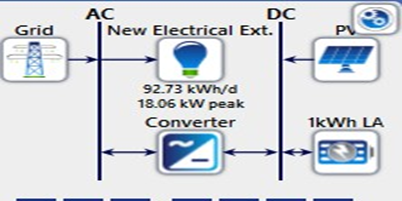
Nigeria faces the dual challenge of harmful industrial emissions contributing to climate change and unreliable power supply, demanding urgent attention. This study focuses on optimizing a grid-connected photovoltaic (PV) system at the Department of Electrical Engineering, Ahmadu Bello University Zaria, Kaduna, Nigeria, with the goal of achieving economic and environmental sustainability. The study utilizes HOMER, a widely used optimization tool for renewable energy systems, to design and evaluate three distinct energy scenarios. The first scenario relies solely on grid power, resulting in high annual costs of $2,838, significant environmental degradation, and zero renewable energy contribution. The second scenario integrates solar PV with grid power, reducing grid dependency but only partially addressing cost and environmental concerns, with an annual energy cost of $2,714 and 1,867 kWh generated from solar PV. The third scenario demonstrates the most favourable outcomes, combining high solar PV generation with economic benefits. The system produces 29,684 kWh annually, selling $521 worth of surplus energy back to the grid, resulting in a net yearly energy cost of $1,043. The initial installation cost is expected to be recovered within two years, offering potential savings of $20,000 over the system's 20-year lifespan. These findings show the viability of solar PV systems as a solution to Nigeria's energy challenges, underscoring the importance of balancing economic and environmental factors in energy system design. The study provides valuable insights for institutions and similar contexts looking to transition to more sustainable energy systems. |
Keywords: Optimization; Renewable Energy Sources; Grid; Environmental Impacts; Cost Effectiveness |
Corresponding Author: Habib Muhammad Usman, Department of Electrical Engineering, Mewar University, Chittorgarh, Rajathan, India. Email: habibusman015@gmail.com |
This work is licensed under a Creative Commons Attribution-Share Alike 4.0 
|
Document Citation: H. M. Usman, N. K. Sharma, D. K. Joshi, B. I. Sani, M. Mahmud, S. Saminu, A. B. Yero, and R. S. Auwal, “Optimization of Grid-Connected PV Systems: Balancing Economics and Environmental Sustainability in Nigeria,” Buletin Ilmiah Sarjana Teknik Elektro, vol. 6, no. 3, pp. 237-253, 2024, DOI: 10.12928/biste.v6i3.11562. |
INTRODUCTION
The global energy sector is undergoing a rapid transformation due to increasing concerns over environmental sustainability and the need for reliable power supply [1]. In Nigeria, the challenges are particularly pronounced, with industrial emissions contributing significantly to global greenhouse gas levels, exacerbating climate change. At the same time, Nigeria suffers from a persistently unreliable power supply, which hampers economic growth and development [2]. As the country relies heavily on non-renewable energy sources like coal and gas, there is an urgent need to transition toward cleaner and more sustainable energy alternatives [3]. Nigeria's energy generation has traditionally relied on thermal, hydroelectric, and fossil fuel sources, making it essential to explore renewable energy alternatives for cleaner and more reliable power [4][5]. Due to financial constraints, extending the national grid to rural areas is often impractical, highlighting the increasing importance of off-grid renewable energy solutions to address electricity shortages in these regions. Consequently, substantial research has focused on assessing the potential of renewable energy sources (RES) to generate both independent and hybrid energy, considering the availability of resources across different geographic areas [6]–[9].
In many developing countries, particularly in Africa, numerous rural communities remain disconnected from the national grid due to the high costs involved [10][11]. As a result, these communities rely on alternative energy sources such as wood and diesel generators for cooking, heating, and lighting [12][13]. However, the reliance on fossil fuels contributes to environmental pollution, further aggravating concerns about global warming. The rising concerns over energy security, environmental sustainability, and the growing global energy demand have driven the need for innovative solutions in the power sector. Grid-connected hybrid systems, which combine conventional grid electricity with renewable energy sources, have emerged as a promising solution to these challenges [14]. These systems offer improved reliability, efficiency, and cost-effectiveness compared to standalone renewable energy installations [15]. Consequently, there has been significant interest in developing and optimizing grid-connected hybrid systems using advanced optimization tools like the Hybrid Optimization Model for Multiple Energy Resources (HOMER). Meanwhile, Nigeria holds vast potential for harnessing renewable energy resources, including wind, solar, biomass, and hydropower, to address its energy challenges. With an annual average solar radiation of 5.25 kWh/m²/day and an average sunshine duration of 6.25 hours per day [16]-[19], Nigeria has a solar radiation range of 3.5 to 7.0 kWh/m²/day across the country, from the northern regions to the coastal areas [20]. Solar energy alone has the potential to generate over 4,000 times more energy than Nigeria’s crude oil production and 13,000 times more than its natural gas production [17].
Several studies have recommended integrating renewable energy sources (RES) into rural electrification projects in Nigeria [21]–[24]. Both standalone RES [24]–[26] and hybrid RES [27]–[30] have been identified as viable options. Standalone RES rely on a single energy source, while hybrid RES combine multiple renewable sources for power generation. Increasingly, hybrid systems that integrate multiple RES are being employed to optimize energy generation and reliability. The inclusion of a diesel-powered generator in hybrid systems further enhances overall efficiency by mitigating the impact of variable weather patterns. Numerous hybrid renewable energy system designs have been extensively studied and implemented, such as solar-wind-battery-diesel configurations [31]–[34] and the integration of wind, solar, and battery storage systems [29]-[31]. These designs have been rigorously tested and have consistently demonstrated their viability in various regions where they have been deployed.
Advanced control strategies, forecasting methodologies, and energy management systems also play a crucial role in improving the performance of grid-connected hybrid systems. HOMER assists stakeholders in making informed decisions by providing optimized system designs, determining appropriate component sizes, and evaluating economic feasibility. By using HOMER, the transition to cleaner energy can be accelerated through the optimization of grid-connected hybrid systems [35][36]. Research consistently underscores the importance of HOMER in optimizing configurations and designing financially sustainable energy systems. HOMER (Hybrid Optimization of Multiple Energy Resources) is a simulation software used to design and optimize hybrid energy systems that combine renewable resources like solar and wind with conventional sources such as diesel generators and the grid. It helps assess the technical and economic feasibility of different system configurations by analyzing energy demand, resource availability, costs, and operational constraints. HOMER identifies the most cost-effective and reliable design, making it a valuable tool for developing both off-grid and grid-connected energy solutions, particularly in enhancing sustainability and energy efficiency [37]. Photovoltaic (PV) systems offer a promising solution to Nigeria's dual challenge of reducing harmful emissions while improving power reliability. Grid-connected PV systems have gained global attention due to their potential to reduce dependence on fossil fuels, mitigate environmental impacts, and provide cost-effective energy solutions. However, balancing the economic viability of such systems with their environmental benefits remains a key challenge, particularly in regions like Nigeria, where energy costs are volatile, and investment in renewable infrastructure is limited [38].
This study makes a significant contribution by advancing the understanding of how to balance economic and environmental considerations in the implementation of grid-connected hybrid photovoltaic (PV) systems for electrification in Zaria, Kaduna State, Nigeria. While previous research has focused on the viability of hybrid renewable energy systems (RES) in other parts of Nigeria, Zaria has been largely overlooked. Additionally, much of the existing literature emphasizes the economic viability of RES while neglecting technical and environmental factors. To address this gap, this study conducts an integrated optimization analysis of grid-connected hybrid PV systems, incorporating technical, economic, and environmental aspects. By leveraging Zaria's abundant solar resources, the study not only explores electrification options for Ahmadu Bello University but also extends the analysis to the broader rural community. Using meteorological data from NASA and the HOMER Pro software, this research identifies the optimal configuration of RES for this region. The study’s findings provide valuable insights into designing sustainable, cost-effective energy solutions that align with Nigeria’s broader energy and sustainability goals. Furthermore, it highlights the importance of considering the unique local context when optimizing energy systems, offering a roadmap for future projects in similar settings.
METHOD
This paper explores the integration of technological, environmental, and economic analyses for grid-connected hybrid photovoltaic system optimization. In particular, Zaria is the intended case study location, and it focuses on using a grid-connected hybrid renewable energy system (HRES) to provide electricity in a rural Nigerian community. The grid, solar PV, and batteries are all optimization elements that are taken into account. System analysis was performed using HOMER optimization software, which allowed designers to compare the technical, financial, and environmental aspects of different configurations and designs. Power systems and harmonic analyzers were also used to test power electronics, inverters, motors and drives, lighting, home appliances, office equipment, power supplies, and industrial machinery, among other various electrical power-related applications. Furthermore, the power system analyzer played a crucial role in gathering load data for the study location. The flowchart of the research methodology is shown in Figure 1.
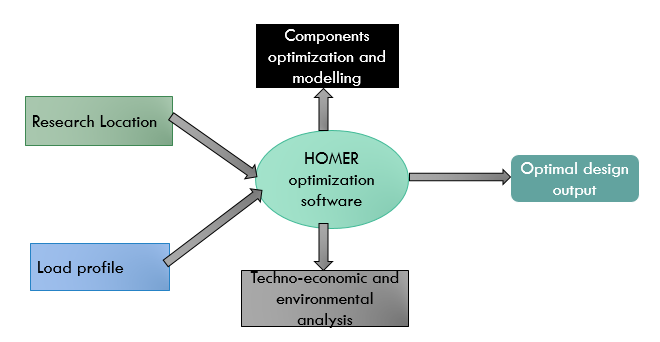
Figure 1. Flowchart of the study methodologies
Methodologies employed in this study are;
- Homer software
- Load profile
- Research Location
- Model input parameter
- Grid Connected Hybrid System Modelling
Homer Software
The HOMER Pro Microgrid Analysis Tool (Version 3.11.2, Pro Edition) was employed in this study to design, size, and optimize the Hybrid Renewable Energy System (HRES) for the selected location. HOMER was specifically chosen for its unique ability to integrate multiple decision-making criteria, such as financial risk, environmental policy, and renewable energy availability, while also providing flexibility for modeling site-specific conditions. Unlike other simulation tools, HOMER offers a comprehensive platform that combines simulation, optimization, and sensitivity analysis, making it well-suited for balancing the economic and environmental considerations central to this study [39]. The software was used to analyze key parameters like the daily load demand profile, seasonal variations, local meteorological data, and existing power generation capabilities, all of which are crucial for effective HRES design. HOMER's optimization capabilities were applied to evaluate metrics such as Net Present Cost (NPC), Levelized Cost of Energy (LCOE), and the initial and maintenance costs associated with various system configurations. This techno-economic analysis ensures that the optimal HRES design is identified, focusing on cost-effectiveness and long-term sustainability as depicted in Figure 2. One of HOMER’s strengths lies in its sensitivity analysis, which was utilized to assess the financial viability of the system under varying operational parameters, such as fluctuating fuel prices, changes in renewable resource availability, and grid tariff variations. This allows for a more robust decision-making process, especially in uncertain and dynamic energy markets [39].
The methodology of this study was divided into four key steps. First, the load profile of the project location was analyzed to understand energy demand patterns. Second, meteorological data, including solar and wind profiles, was collected from reliable sources like NASA. Third, the system components, including PV panels, wind turbines, inverters, and batteries, were optimized, taking into account their sizing, costs, and operational efficiency. Finally, HOMER’s optimization engine was applied to identify the most cost-effective HRES configuration, followed by a detailed analysis of its financial feasibility.
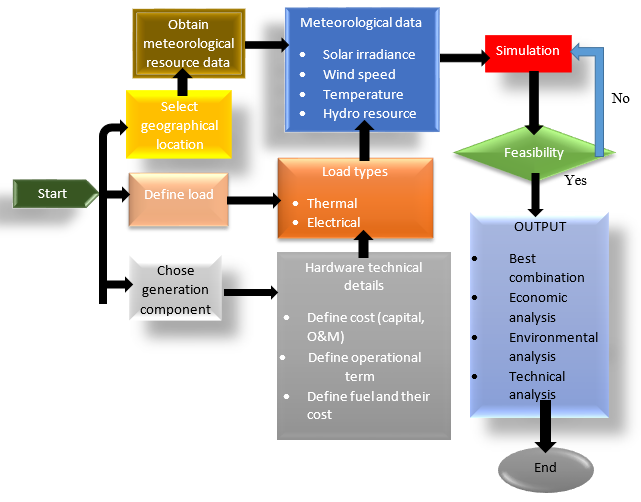
Figure 2. Homer optimization procedure
Load Profile Analysis
To accurately assess the energy demands of the study location, a detailed load profile analysis was conducted. This process began by setting up a power system analyzer directly on the distribution board, which continuously monitored and recorded the power usage patterns as depicted in Figure 3. The analyzer captured key metrics such as voltage, current, power factor, and energy consumption, providing a comprehensive view of daily and seasonal variations in electrical load. The data collection was carried out over several weeks to capture typical usage trends, considering factors such as peak demand periods, off-peak usage, and potential seasonal fluctuations in energy consumption. This long-term monitoring was necessary to establish an accurate load profile that reflects both routine and variable electricity demands within the system. Challenges during data collection included managing periods of inconsistent electricity supply, common in Nigeria, which could distort the load profile. To address this, backup data collection systems were implemented, and adjustments were made to filter out anomalies in the collected data.
The resulting load profile became a crucial input for the optimization process, ensuring that the designed Hybrid Renewable Energy System (HRES) aligns with the real energy needs of the area. The detailed load profile also allowed the study to identify potential inefficiencies in the current system and make targeted improvements in the proposed HRES design, improving both energy efficiency and cost-effectiveness.
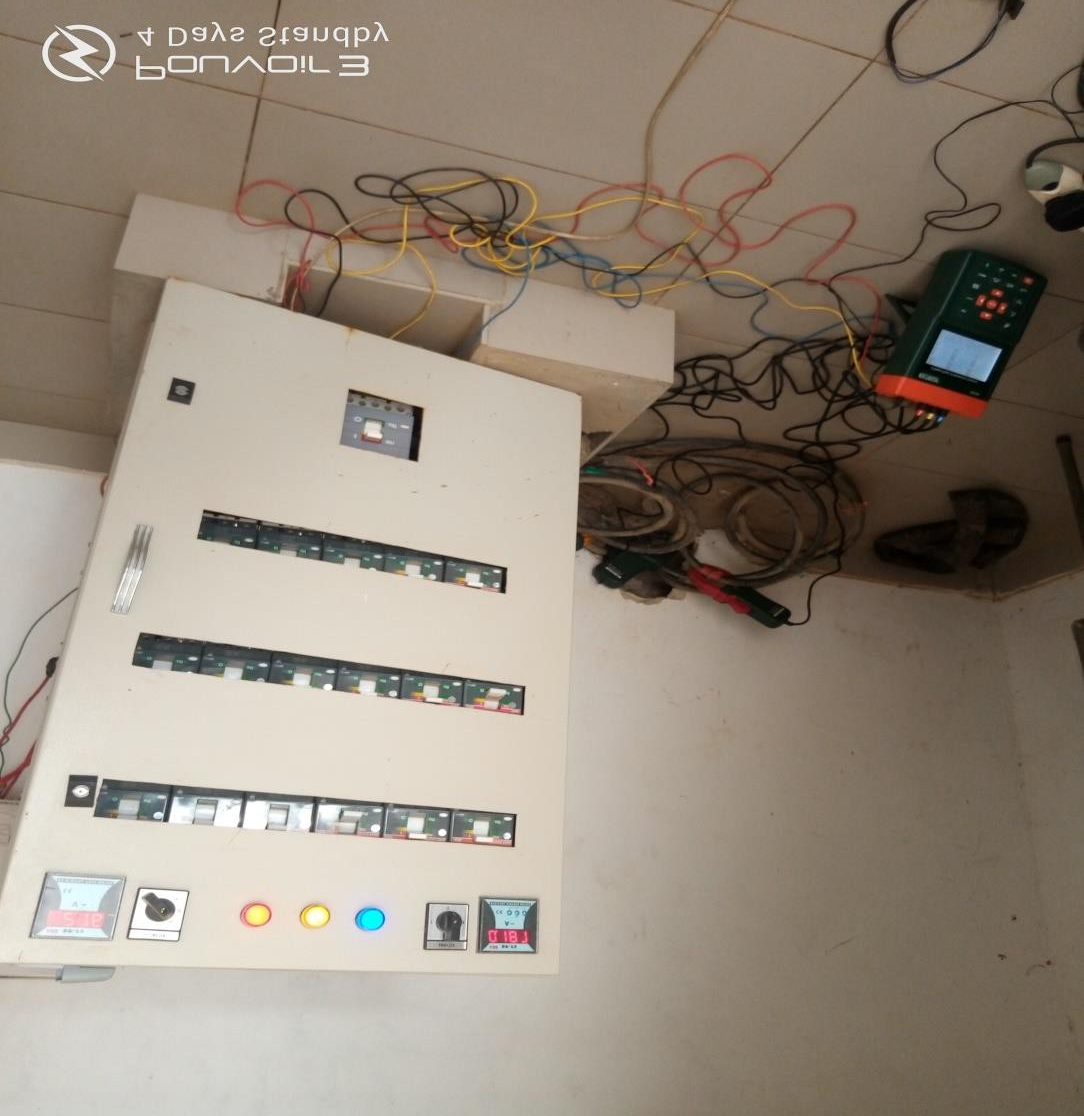
Figure 3. Power system analyzer connected with the distribution board
The research site's daily load profile, as shown in Figure 4, shows that, over the course of a year, energy consumption averaged 92.73 kWh per day, with a peak demand of 18.06 kW spread throughout the day. In order to properly satisfy the energy demands, the hybrid renewable energy system must be designed and optimized with this load profile in mind.
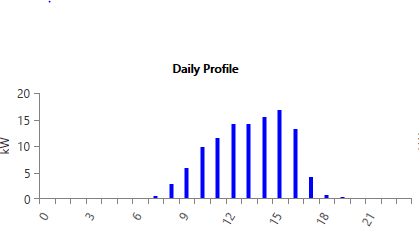
Figure 4. Daily load profile of the proposed research site
Research Location
The study was conducted at the Electrical Engineering building of Ahmadu Bello University, Zaria, with precise geographic coordinates of 11°9.6'N latitude and 7°38.3'E longitude, as depicted in Figure 5. This location was strategically chosen due to its significant energy needs, being part of a large academic institution with substantial and consistent electricity demand. Moreover, the region offers favourable geographical conditions for solar energy, making it ideal for a study focused on optimizing grid-connected photovoltaic (PV) systems. The selected coordinates were also critical for accurately calculating solar radiation levels, utilizing data from NASA's surface meteorology and solar energy database, as shown in Table 1. These factors, including existing infrastructure and the site's suitability for solar energy harvesting, make this location an optimal choice for evaluating renewable energy solutions.

Figure 5. Coordinate of the research site
Table 1. Solar radiation data
Month | Solar irradiance (kWh/m2/day) | Solar irradiance (kWh/m2/day) | Solar irradiance (kWh/m2/day) | Solar irradiance (kWh/m2/day) | Average Daily radiation (kWh/m2/day) |
2020 | 2021 | 2022 | 2023 | Average of the years |
January | 5.50 | 5.60 | 5.55 | 5.65 | 5.575 |
February | 5.9 | 6.1 | 6.0 | 6.0 | 5.999 |
March | 6.3 | 6.4 | 6.35 | 6.35 | 6.348 |
April | 6.45 | 6.5 | 6.4 | 6.55 | 6.474 |
May | 6.4 | 6.5 | 6.45 | 6.52 | 6.455 |
June | 6.0 | 6.1 | 6.05 | 6.2 | 6.086 |
July | 5.3 | 5.4 | 5.35 | 5.36 | 5.352 |
August | 5.1 | 5.2 | 5.15 | 5.16 | 5.154 |
September | 5.75 | 5.9 | 5.8 | 5.8 | 5.812 |
October | 6.2 | 6.3 | 6.3 | 6.35 | 6.285 |
November | 6.1 | 6.2 | 6.05 | 6.2 | 6.13 |
December | 5.75 | 5.8 | 5.8 | 5.85 | 5.801 |
The monthly sun irradiance data for 2020–2023 is shown in Table 1, where average daily radiation levels show a strong potential for solar energy utilization at Ahmadu Bello University Zaria's Department of Electrical Engineering. The data indicates that solar irradiance is constant over the year, peaking in April at 6.474 kWh/m²/day and falling in August to 5.154 kWh/m²/day on average. This implies that a solar photovoltaic system may be used efficiently all year round.
Model Input Parameter
In this study, the model parameters were carefully selected using the HOMER software to simulate a grid-connected hybrid system consisting of a PV array, battery storage, converter, and the grid. The choice of these components was based on their technical performance, lifespan, and economic impact, and sensitivity analyses were conducted to determine the most optimal configuration. The following subsections describe the model components and the rationale for their selection.
- PV Array
The simulation uses a generic flat-plate PV array with a lifespan of 20 years and an efficiency of approximately 80%. This efficiency, typical for flat-plate PV systems, ensures that 80% of the sunlight captured is converted into electrical energy, indicating high performance under typical operating conditions. The long lifespan of the array significantly contributes to its economic viability, reducing the need for frequent replacements and minimizing maintenance costs. A sensitivity analysis was conducted to assess the impact of varying efficiency and lifespan on the system's overall performance. The PV array plays a crucial role in minimizing the reliance on grid power, leading to a lower levelized cost of energy (LCOE) over the system's lifetime, despite the high initial capital investment.
- Storage
The energy storage system in this study consists of a generic 100 kWh lithium-ion battery with an 80% round-trip efficiency and a 10-year lifespan. Lithium-ion technology was chosen due to its high efficiency and relatively long lifespan, which balances the need for efficient energy management with the cost of periodic replacement. The storage system captures excess energy generated by the PV array and releases it during periods of low solar production, ensuring optimal resource utilization and grid independence. Sensitivity analysis was applied to evaluate the financial feasibility of the storage system under different operating conditions, such as battery lifespan and efficiency. Although the initial investment and replacement costs are high, the battery's efficiency helps maintain a steady power supply, reducing reliance on the grid and improving overall system economics.
- Converter
A system converter with a 95% efficiency and a 15-year lifespan was selected to manage the conversion of direct current (DC) generated by the PV array and stored in the batteries into alternating current (AC) for grid and load use. The 95% efficiency means that only 5% of energy is lost during conversion, ensuring that the majority of generated and stored energy is available for consumption. The long lifespan of the converter minimizes the need for frequent replacements, further improving the system’s economic profile. A sensitivity analysis was conducted to examine the effect of varying conversion efficiency and lifespan on the system’s cost-effectiveness and performance.
- Grid
In the simulation, the grid serves two purposes: as a backup power source and as a sink for excess power generated by the PV array. When the renewable energy sources (RES) do not meet the load demand, the grid ensures a continuous power supply. Conversely, any surplus electricity generated by the PV array can be fed back into the grid, potentially generating revenue depending on grid regulations. Economically, the grid connection provides reliability by reducing the risk of power outages and offering opportunities to sell excess electricity. The balance between the cost of grid connection and the revenue potential from surplus energy sales was evaluated to optimize the system's financial performance. Table 2 summarizes the component selection optimization.
Table 2. Summary of the selected optimized components
Component | Parameter | Details | Rationale |
PV Array | Type | Generic Flat-Plate PV Array | Commonly used due to its durability and efficiency in converting sunlight into electricity. |
| Lifespan | 20 years | Long lifespan reduces the frequency of replacements and maintenance, improving economic viability. |
| Efficiency | 80% | High efficiency ensures the effective conversion of sunlight into electrical energy. |
| Sensitivity Analysis | Analysed variations in efficiency and lifespan to assess impact on system performance and cost. | Helps determine the optimal balance between initial investment and long-term performance. |
Storage | Type | Generic 100 kWh Lithium-Ion Battery | Selected for high efficiency and relatively long lifespan compared to other battery types. |
| Efficiency | 80% Round-Trip Efficiency | Indicates the proportion of stored energy that can be recovered, essential for effective energy management. |
| Lifespan | 10 years | Balances cost and performance, although replacement will be necessary, influencing total system cost. |
| Sensitivity Analysis | Evaluated different operating conditions such as lifespan and efficiency. | Assesses financial feasibility and system reliability under varying scenarios. |
Converter | Type | System Converter | Converts DC from PV array and storage to AC for use by the grid and loads. |
| Efficiency | 95% | High efficiency minimizes energy loss during conversion, maximizing available power. |
| Lifespan | 15 years | Extended lifespan reduces maintenance and replacement frequency, improving economic efficiency. |
| Sensitivity Analysis | Assessed impact of conversion efficiency and lifespan on system performance and cost. | Determines optimal converter specifications for cost-effectiveness and reliability. |
Grid | Function | Backup Power Source and Excess Power Sink | Provides reliability and absorbs surplus electricity, contributing to system flexibility. |
| Economic Impact | Cost of connection, potential revenue from surplus power sales | Balances the cost of grid connection with potential revenue, optimizing overall system economics. |
Grid-Connected Hybrid System Modelling
The hybrid system examined in this study comprises a grid connection, solar PV panels, batteries and a converter. Modelling and optimizing the system's energy were performed using HOMER software. The solar PV system, batteries, converter and grid were all modelled and optimized. Figure 6 illustrates the hybrid design created using HOMER software.

Figure 6. Design of the optimal grid-connected PV system
- Solar PV Modelling
In a solar setup, power is produced by a series or parallel arrangement of interconnected solar panels. The amount of power generated by solar panels is measured using equation (1) [37].
| 
| (1) |
The rated power at a reference situation is represented by  in this equation, whereas the output power of the photovoltaic (PV) cells is written as
in this equation, whereas the output power of the photovoltaic (PV) cells is written as  . The solar radiation at a standard temperature is denoted as
. The solar radiation at a standard temperature is denoted as  (where Gref = 1000 W/m2), and the solar radiation is represented as
(where Gref = 1000 W/m2), and the solar radiation is represented as  (measured in W/m2). The temperature of the cell under standard conditions is indicated by Tref (25°C). The ambient temperature is denoted by Tc, while the temperature coefficient is expressed as α.
(measured in W/m2). The temperature of the cell under standard conditions is indicated by Tref (25°C). The ambient temperature is denoted by Tc, while the temperature coefficient is expressed as α.
- Battery Modelling
The battery is a part of the system design that stores energy in case the weather makes it impossible for renewable energy sources (RES) to generate power. The battery's stored energy powers the load when solar irradiance is not enough to power it, preventing the need for backup generators throughout the night. Numerous factors, such as battery capacity, rate of charge and discharge, and state of charge (SOC), affect this utilization. The formula for figuring out the battery storage capacity is given by equation (2) [37]. Where  stands for daily average daily energy,
stands for daily average daily energy,  signifies the numbers of days of autonomy,
signifies the numbers of days of autonomy,  represents depth of charge,
represents depth of charge,  represents inverter efficiency,
represents inverter efficiency,  is the battery efficiency.
is the battery efficiency.
| 
| (2) |
- Grid Connected Modelling
The HOMER software effectively models the interaction between the renewable energy system and the grid through a dynamic grid equation. Although HOMER does not rely on a single, fixed equation to define grid modeling, it employs a flexible approach to illustrate how the power generated by renewable sources is integrated with grid electricity. This interaction is captured through various algorithms within HOMER that manage the balance between renewable energy production and grid power supply. Specifically, HOMER optimizes grid interactions by adjusting parameters such as energy storage, load demand, and grid import/export limits. This approach allows the software to address challenges related to balancing power between the grid and renewable sources, ensuring both efficiency and reliability in the energy system. Where, Power taken from (or supplied to) the grid is referred to as the  .
.  is the total amount of electricity that the system needs to run. The electricity produced by the renewable energy system is represented as
is the total amount of electricity that the system needs to run. The electricity produced by the renewable energy system is represented as  .
.
Equation (3) shows how the quantity of electricity generated by renewable energy sources and the total amount of electricity required by the system interact, influencing how much power is exported or taken from the grid. The extra electricity generated by the renewable energy system can be sent to the grid. On the other hand, more power can be taken from the grid to meet the demand if it exceeds the renewable supply.
| 
| (3) |
RESULTS AND DISCUSSION
The optimization utilizing HOMER software produced three different configurations, each having advantages in terms of economy, technology, and the environment. The outcomes of this optimization are shown in this part. The benefits and downsides of each design were thoroughly discussed and examined, taking into account aspects like environmental impact, system reliability, and cost-effectiveness. Following a thorough analysis, the design that performed best overall was determined by looking at all of these factors combined.
Results of the First Scenario
As shown in Table 3, the first optimization scenario involves a grid-only configuration with no contribution from renewable energy sources. Although this setup results in minimal capital costs due to the exclusive reliance on grid electricity purchases, it presents several significant drawbacks. These include environmental impacts from increased greenhouse gas emissions associated with fossil fuel-based power generation and vulnerability to price volatility and supply disruptions. The reliance on grid electricity alone fails to address long-term sustainability concerns and environmental risks, which are critical considerations in modern energy system design.
The data displays a consistent pattern of energy usage, with monthly consumption ranging from 1.075 kW in November to 3.633 kW in April, totalling 33.408 kW annually as depicted in Figure 7. Similarly, monthly energy purchases from the grid mirror these consumption figures, totalling 33.408 kW annually. The associated energy charges for purchases vary from $92 in November to $310 in April, accumulating to an annual charge of $2.838. This result indicates a consistent dependence on grid energy to fulfil the load requirements throughout the year, emphasizing the significance of renewable energy integration to potentially mitigate reliance on the grid.
Tabel 3. First scenario result, Grid-connected to the load without renewable source
Month | Energy Consumed (kW) | Energy Purchased (kW) | Energy Charges ($) |
January | 3.276 | 3.276 | 279 |
February | 3.044 | 3.044 | 259 |
March | 3.593 | 3.593 | 305 |
April | 3.633 | 3.633 | 310 |
May | 3.572 | 3.572 | 304 |
June | 3.388 | 3.388 | 288 |
July | 3.016 | 3016 | 256 |
August | 2.559 | 2.560 | 213 |
September | 2.476 | 2.476 | 210 |
October | 2.666 | 2.666 | 227 |
November | 1.075 | 1.075 | 92 |
December | 1.110 | 1.110 | 95 |
Annual | 33408 | 33408 | 2.838 |

Figure 7. Grid-connected to the load without renewable source
Results of the Second Scenario
The results of the second scenario highlight the necessity of integrating the solar PV system with the grid to achieve optimal system performance. While the initial costs of this configuration are higher due to the investment in the solar PV panels, battery storage, and inverter, the long-term benefits—such as reduced grid dependency and potential cost savings over time—are substantial. As shown in Table 4, the solar PV system operates for 6.134 hours annually, producing 2.428 kWh of energy. After passing through the system converter, 2.307 kWh is delivered to the load, with 121 kWh lost in conversion Table 5. Shows PV/battery/grid connected hybrid system for the second scenario result throughout the year.
Table 4. Annual energy generation by the PV System
Quantity | Value | Units |
Hours of Operation | 6.134 | hrs/yr |
Energy Out | 2.307 | kWh/yr |
Energy In | 2.428 | kWh/yr |
Losses | 121 | kWh/yr |
Table 5. PV/battery/grid connected hybrid system for the second scenario result
Month | Energy consumed(kW) | PV power generated (kW) | Energy Purchased (kW) | Energy sold (kW) | Energycharge ($) | Energy sold ($) |
January | 3.276 | 106 | 3.244 | 73.6 | 278 | 6 |
February | 3.044 | 123 | 2.954 | 33.7 | 251 | 2.9 |
March | 3.593 | 166 | 3.464 | 36.4 | 294 | 3 |
April | 3.633 | 199 | 3.457 | 26.8 | 293 | 2.1 |
May | 3.572 | 212 | 3.383 | 23.1 | 288 | 1.8 |
June | 3.388 | 207 | 3.197 | 15.8 | 272 | 1.3 |
July | 3.016 | 202 | 2.829 | 14.7 | 240 | 1.2 |
August | 2.559 | 158 | 2.417 | 15.7 | 205 | 1.3 |
September | 2.476 | 154 | 2.347 | 24.6 | 199 | 2.0 |
October | 2.666 | 139 | 2.552 | 25.1 | 217 | 2.0 |
November | 1.075 | 103 | 1.025 | 53.0 | 87 | 4.2 |
December | 1.110 | 98 | 1.063 | 50.5 | 90 | 4.0 |
Annual | 33408 | 1867 | 31.932 | 393 | 2.714 | 31.8 |
The system's performance, as outlined in Table 5 and Figure 8 and Figure 9, provides a comprehensive view of energy dynamics throughout the year. Monthly energy consumption ranges from 1.075 kWh to 3.633 kWh, totalling 33.408 kWh annually. PV generation fluctuates seasonally, producing 1.867 kWh annually, with monthly outputs varying between 98 kWh and 212 kWh, which affects the overall reliability and sustainability of the system. The grid plays a crucial balancing role, with monthly grid energy acquisition ranging from 1.025 kWh to 3.464 kWh, contributing to an annual total of 31.932 kWh. Additionally, the energy sold back to the grid, which varies from 15.8 kWh to 73.6 kWh monthly and totals 393 kWh annually, is significant. This surplus energy not only improves the system's overall economic viability by generating revenue but also demonstrates the potential of such a hybrid system to contribute to the grid, further reducing reliance on conventional power sources.
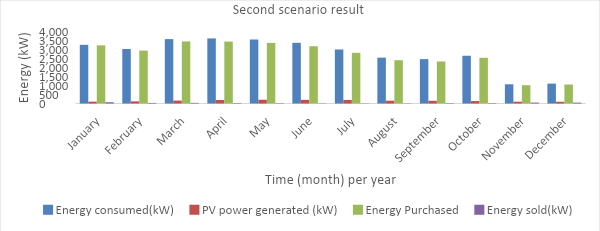
Figure 8. PV/battery/grid connected hybrid system for the second scenario result
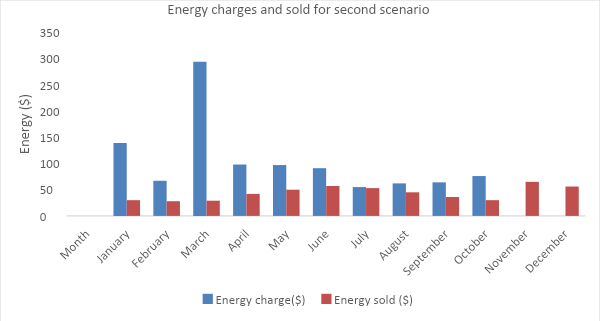
Figure 9. Energy purchased and sold for the second scenario in ($)
The distribution of annual energy production between grid purchases and a standard flat plate photovoltaic (PV) system is shown in Table 6 and Figure 10. The annual energy production from the PV system is 1.867 kWh, or around 5.52% of total energy production. The remaining 31.932 kWh come from grid purchases, accounting for 94.48% of the total energy production. When these sources are combined, 33.799 kWh of energy are produced annually. In comparison to the renewable energy produced by the PV system, this breakdown shows a considerable dependency on grid purchases. This emphasizes the necessity for additional integration of renewable sources to lessen reliance on conventional grid electricity.
Table 6. Energy produced annually by the PV and the grid purchase for second scenario
Component | Production (kWh/yr) | Percent (%) |
Generic flat plate PV | 1867 | 5.52 |
Grid purchase | 31.932 | 94.48 |
Total | 33.799 | 100 |
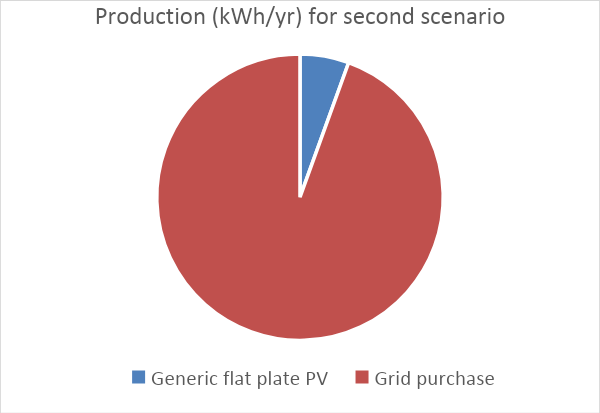
Figure 10. Energy produced annually by the PV and the grid purchase for second scenario
As displayed in Table 7, with an annual total of 33.408 kWh, or 98.84% of the total consumption, the AC primary load is the source of the majority of energy use. The DC main load uses no energy at all. 393 kWh, or 1.16% of the total energy consumption, are sold back to the grid by the system. The overall annual energy usage of the system is 33.801 kWh.
Table 7. Energy consumed by the AC primary load and grid energy sales
Component | Consumption (kWh/yr) | Percent |
AC Primary Load | 33408 | 98.84 |
DC Primary Load | 0 | 0 |
Grid sales | 393 | 1.16 |
Total | 33.801 | 100 |
The annualized expenses of the generic flat-plate PV, grid, generic 100 kWh battery, and system converter are shown in Table 8. The annualized total cost of the generic flat plate PV is $459, which includes capital, operational, and replacement costs. The grid component has no initial capital costs, however, it does have substantial yearly operational costs of $2.714 to pay. The annualized cost of the common 100 kWh battery is $485, which includes capital, operating, and replacement expenditures. Finally, the system converter has an annualized cost of $321 which includes operating, replacement, and capital costs.
Table 8. Annualized cost of the energy of the second scenario result
Components | Capital ($) | Operating ($) | Replacement ($) | Total ($) |
Generic flat plate PV | 224 | 35 | 200 | 459 |
Generic Battery 100kWh | 250 | 10 | 215 | 485 |
System Converter | 153 | 15 | 153 | 321 |
Results of the Third Scenario
In the third scenario, the system integrates PV, battery, and grid-connected hybrid components, similar to the second scenario. However, a significant portion of the energy delivered to the load comes directly from the PV system, reducing dependence on the grid. Although this configuration has the highest initial cost compared to the previous two scenarios, the long-term benefits, both financial and environmental, outweigh these upfront expenses, leading to eventual cost savings and profits. Table 9 details the operational parameters of the converter and PV system, showing that the PV system operates for 6.134 hours annually, generating 29.982 kWh of energy, with 29.682 kWh delivered to the load after passing through the converter. The system experiences 298 kWh of losses, which, while minor, should be analysed further to identify potential optimizations in future system designs.
The performance metrics of a PV/battery/grid connected hybrid system for the third optimization outcome during a twelve-month period are shown in Table 10, Figure 11 and Figure 12. With a monthly energy consumption range from 1.075 kW to 3.633 kW and an annual total of 33.408 kW, it depicts the energy dynamics of the system. With an annual total of 29.684 kW, the PV system exhibits fluctuating electricity generation, peaking at 3.003 kW in April. Energy sold back to the grid fluctuates from 343 kW in February to 804 kW in November, with an annual total of 6.466 kW. Energy purchased from the grid ranges from 0 kW in November and December to 1.640 kW in January.
Table 9. Annual energy generation by the PV System
Quantity | Value | Units |
Hours of Operation | 6.134 | hrs/yr |
Energy Out | 29.684 | kWh/yr |
Energy In | 29.982 | kWh/yr |
Losses | 298 | kWh/yr |
Table 10. PV/battery/grid connected hybrid system for the third scenario result
Month | Energy consumed(kW) | PV power generated (kW) | Energy Purchased (kW) | Energy sold (kW) | Energy charge ($) | Energy sold ($) |
January | 3.276 | 2.011 | 1640 | 375 | 139 | 30 |
February | 3.044 | 2.593 | 794 | 343 | 67 | 28 |
March | 3593 | 2.815 | 1142 | 364 | 294 | 29 |
April | 3.633 | 3.003 | 1157 | 527 | 98 | 42 |
May | 3572 | 3.047 | 1147 | 622 | 97 | 50 |
June | 3.388 | 3.029 | 1073 | 714 | 91 | 57 |
July | 3016 | 3023 | 650 | 659 | 55 | 53 |
August | 2.559 | 2.361 | 730 | 543 | 62 | 45 |
September | 2.476 | 2110 | 753 | 445 | 64 | 36 |
October | 2.666 | 2.002 | 896 | 367 | 76 | 30 |
November | 1.075 | 1.895 | 0 | 804 | 0 | 65 |
December | 1.110 | 1.795 | 0 | 703 | 0 | 56 |
Annual | 33.408 | 29.684 | 9.982 | 6.466 | 1.043 | 521 |
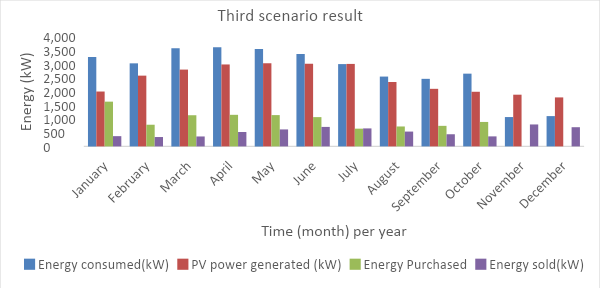
Figure 11. PV/battery/grid connected hybrid system energy for the third scenario result
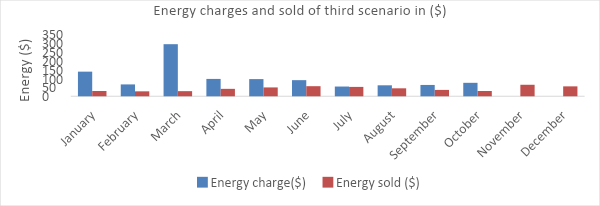
Figure 12. Energy purchased and sold for third optimization in ($)
The annual energy production breakdown for a system with a standard flat plate photovoltaic (PV) setup and grid purchases is shown in Table 11 and Figure 13. The average flat plate photovoltaic system produces 29.684 kWh of electricity per year or 74.83% of the total energy produced. On the other hand, grid purchases account for 9.982 kWh each year, or 25.17% of the total energy produced. When these sources are combined, 39.666 kWh of energy are produced annually. This breakdown reveals a substantial reliance on renewable energy from the PV system, which provides the majority of the energy produced. The remaining energy needs are met via grid purchases.
Table 11. Energy produced annually by the PV and the grid purchase
Component | Production (kWh/yr) | Percent |
Generic flat plate PV | 29.684 | 74.83 |
Grid purchase | 9.982 | 25.17 |
Total | 39.666 | 100 |
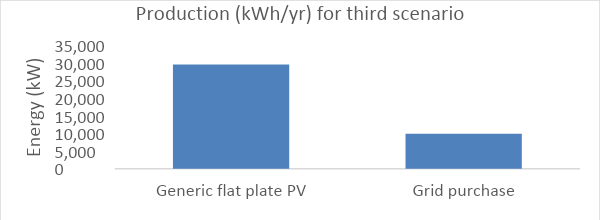
Figure 13. Energy produced annually by the PV and the grid purchase for the third scenario
The annual energy usage breakdown for a system's grid sales and AC primary load is shown in Table 12. The yearly energy consumption of the AC primary load is 33.408 kWh, or 83.78% of the total energy consumption. The DC main load uses no energy at all. 6.466 kWh of energy are sold back to the grid by the system, making up approximately 16.22% of the total energy used. When these sources are combined, the annual energy usage comes to 39.874 kWh. This breakdown shows how much energy the AC primary load uses, and that some of that energy is sold back to the grid. This suggests ways to optimize energy use and better integrate renewable energy sources to reduce reliance on the grid.
Table 12. Energy consumed by the AC primary load and the grid sales
Component | Consumption (kWh/yr) | Percent |
AC Primary Load | 33408 | 83.78 |
DC Primary Load | 0 | 0 |
Grid sales | 6.466 | 16.22 |
Total | 39.874 | 100 |
The yearly cost breakdown for the energy system components of the third optimization outcome is shown in Table 13. The annualized total cost of the generic flat plate PV system is $2.318. This cost is made up of capital, operating, and replacement costs. On the other hand, the grid component requires no initial capital expenditure but has significant ongoing expenses of $1.043 per year. The annualized cost of the common 100 kWh battery is $886, which includes capital, operating, and replacement expenditures. In addition, the system converter has a yearly cost of $634 which includes operating, replacement, and capital costs.
Table 13. Annualized cost of the energy of third scenario result
Name | Capital ($) | Operating ($) | Replacement ($) | Total ($) |
Generic flat plate PV | 1.230 | 60 | 1.028 | 2.318 |
Grid | 0.00 | 1.043 | 0.00 | 1.043 |
Generic Battery 100kWh | 451 | 20 | 415 | 886 |
System Converter | 287 | 20 | 287 | 634 |
Discussion of Results and Comparative Analysis
In the first scenario, the system relies solely on grid electricity to meet the entire energy demand, as shown in Table 3 and Figure 7. Although this configuration incurs minimal capital expenditure, since there’s no investment in renewable energy technologies—there are significant drawbacks which include high energy charges, and environmental concerns due to reliance on the grid which was fossil fuel-based. The yearly cost of grid electricity is $2.838, but this figure may rise due to fluctuating energy prices, particularly since Nigeria’s electricity largely comes from coal-based thermal power plants. These plants not only experience erratic pricing but also contribute heavily to environmental degradation through greenhouse gas emissions and water pollution. Additionally, Nigeria's frequent power outages create system instability, directly affecting the university’s academic activities. As a result, this scenario presents high operational costs, environmental concerns, and vulnerability to energy supply disruptions. The long-term reliance on coal-based grid electricity in this setup, while cost-effective in the short term, is unsustainable, rigid, and prone to future cost increases.
The second scenario integrates a solar PV system with the grid, offering a hybrid solution. Table 5, Figure 8, and Figure 9 show that the solar PV system produces 1.867 kWh annually, while 31.932 kWh are imported from the grid. A small surplus of 393 kWh is sold back to the grid, generating $31.8 in revenue. This configuration results in a grid dependency of 94.48%, with the PV system contributing just 5.52% of the total energy. The capital and operating costs for the PV system are $687, with a replacement cost of $568. Although this scenario reduces grid reliance slightly, it still exposes the system to the risks of fluctuating energy prices and environmental consequences associated with coal-based grid electricity. Economically, the solar PV system does provide minor cost savings and environmental benefits, but the dependence on grid electricity continues to drive high operational costs ($2.714 annually). The limited contribution of the PV system to the overall energy supply limits the long-term financial and environmental advantages of this setup.
The third scenario represents a solar PV-dominant hybrid system, offering a significant shift in energy dynamics. In this setup, the PV system generates 29,684 kWh annually (74.83% of the total energy), while grid purchases account for only 9,982 kWh (25.17%). Additionally, 6.466 kWh of surplus energy is sold back to the grid, generating $521 in revenue. The total cost for energy purchases from the grid is $1.043, resulting in a net yearly expenditure of just $522 when factoring in revenue from excess energy sales. The capital and operating costs for the PV system in this scenario rise to $2.038, with a replacement cost of $1.730. However, the reduction in grid dependence leads to a more sustainable and resilient energy system. The higher initial costs are offset by long-term savings, as the system's operating expenses are significantly lower than in the first and second scenarios. Over a 20-year period, this configuration is expected to save around $20.000, with the initial investment recovered within two years. Environmentally, this setup has a much lower carbon footprint, as reliance on coal-based grid electricity is substantially reduced, aligning with broader sustainability goals. Table 14 summarises the comparative analysis of all the scenarios.
Table 14. Comparative analysis and summary table
Metric | Scenario 1 | Scenario 2 | Scenario 3 |
Annual Energy Demand (kWh) | 33.048 | 33.048 | 33.048 |
Energy from PV (kWh) | 0 | 1.867 (5.52%) | 29.684 (74.83%) |
Energy from Grid (kWh) | 33.048 (100%) | 31.932 (94.48%) | 9.982 (25.17%) |
Energy Sold to Grid (kWh) | 0 | 393 | 6.466 |
Annual Energy Cost ($) | 2.838 | 2.714 | 1.043 |
Revenue from Energy Sold ($) | 0 | 31.8 | 521 |
Net Annual Cost ($) | 2.838 | 2.682 | 522 |
Capital Costs ($) | 0 | 687 | 2.038 |
Replacement Costs ($) | 0 | 568 | 1.730 |
Environmental Impact | High (Coal Dependent) | Moderate (Coal + PV) | Low (PV Dominant) |
Reliance on Grid (%) | 100% | 94.48% | 25.17% |
Environmental Impact and Broader Implications
The environmental benefits of the third scenario are evident, as the PV-dominant hybrid system significantly reduces reliance on coal-generated electricity, lowering greenhouse gas emissions. By offsetting approximately 74.83% of the total energy demand with solar power, this system contributes to broader sustainability goals, including reducing carbon footprints and promoting renewable energy adoption. Implementing such systems can also aid in Nigeria's transition to cleaner energy sources, aligning with national and global energy transition initiatives. The broader implications of adopting a PV-dominant system extend beyond cost savings and environmental impact. This configuration promotes energy independence, mitigates risks associated with fluctuating energy prices, and increases the resilience of power systems in regions prone to power outages. Encouraging the adoption of such systems supports the global movement toward clean energy and sustainability while also contributing to local economic stability and energy security.
CONCLUSION
This study addresses the urgent need for sustainable and cost-effective energy solutions in Nigeria by optimizing a grid-connected PV system at Ahmadu Bello University, Zaria, using HOMER software. Through the analysis of three energy scenarios, the solar PV-dominant configuration proved to be the most economically and environmentally favorable, reducing annual energy costs to $1.043, recovering its initial investment within two years, and saving approximately $20.000 over 20 years. In contrast, the grid-only and grid-PV hybrid systems showed higher costs and greater reliance on coal-based grid electricity, which contributes to environmental degradation and financial instability. The findings emphasize the importance of adopting solar PV systems to reduce grid dependency, cut emissions, and enhance energy resilience. The research offers practical insights for stakeholders in Nigeria’s energy sector, with broader applicability to regions facing similar challenges, and calls for policy support, incentives, and advanced technologies like energy storage and smart grids to optimize future energy systems.
ACKNOWLEDGEMENT
I would like to express my sincere gratitude to the Department of Electrical Engineering at Ahmadu Bello University, Zaria, Kaduna State, Nigeria for their invaluable support throughout the duration of this research work. Special thanks are extended to the faculty members for their supervision, guidance, and expertise, which greatly facilitated the completion of this work. Additionally, I am grateful for access to the high-speed computers provided by the department, which were instrumental in conducting the necessary simulations and analyses. This research would not have been possible without their unwavering support and encouragement.
REFERENCES
- H. M. Usman, M. Mahmud, M. S. Yahaya, and S. Saminu, "Wind-powered agriculture: Enhancing crop production and economic prosperity in arid regions," Elektrika, vol. 16, no. 1, pp. 10-19, 2024, https://doi.org/10.26623/elektrika.v16i1.8999.
- M. Mukhtar, S. Obiora, N. Yimen, Z. Quixin, O. Bamisile, P. Jidele, and Y. Irivboje, "Effect of inadequate electrification on Nigeria’s economic development and environmental sustainability," Sustainability, vol. 13, p. 2229, 2021, https://doi.org/10.3390/su13042229.
- O. O. Mohammed, A. O. Otuoze, S. Salisu, O. Ibrahim, and N. A. Rufa’i, "Virtual synchronous generator: An overview," Nigerian Journal of Technology, vol. 38, no. 1, pp. 153-164, 2019, https://doi.org/10.4314/njt.v38i1.20.
- S. Salisu, M. W. Mustafa, and M. Mustapha, "A wavelet-based solar radiation prediction in Nigeria using adaptive neuro-fuzzy approach," Indonesian Journal of Electrical Engineering and Computer Science, vol. 12, no. 3, pp. 907-915, 2018, https://doi.org/10.11591/ijeecs.v12.i3.pp907-915.
- S. Salisu, "New model for solar radiation estimation from measured air temperature and relative humidity in Nigeria," Nigerian Journal of Technology, vol. 36, no. 3, pp. 917-922, 2017, https://doi.org/10.4314/njt.v36i3.35.
- B. Aderemi, S. Chowdhury, T. Olwal, and A. Abu-Mahfouz, "Techno-economic feasibility of hybrid solar photovoltaic and battery energy storage power system for a mobile cellular base station in Soshanguve, South Africa," Energies, vol. 11, no. 6, p. 1572, 2018, https://doi.org/10.3390/en11061572.
- P. C. Okonkwo et al., “Economic evaluation of hybrid electrical systems for rural electrification: A case study of a rural community in Nigeria,” International Journal of Green Energy, vol. 19, no. 10, pp. 1059-1071, 2022, https://doi.org/10.1080/15435075.2021.1979982.
- S. Ruiz, R. A. Márquez, and O. J. Espinosa, "Optimal design of a diesel-PV-wind system with batteries and hydro pumped storage in a Colombian community," in 2017 IEEE 6th International Conference on Renewable Energy Research and Applications (ICRERA), pp. 234-239, 2017, https://doi.org/10.1109/ICRERA.2017.8191272.
- P. Suhane, S. Rangnekar, A. Mittal, and A. Khare, "Sizing and performance analysis of standalone wind-photovoltaic based hybrid energy system using ant colony optimisation," IET Renewable Power Generation, vol. 10, no. 7, pp. 964-972, 2016, https://doi.org/10.1049/iet-rpg.2015.0394.
- C. Monyei, A. Adewumi, and K. Jenkins, "Energy injustice in off-grid rural electrification policy: South Africa in focus," Energy Research & Social Science, vol. 44, pp. 152-171, 2018, https://doi.org/10.1016/j.erss.2018.05.002.
- N. Lambani, C. Buque, and S. Chowdhury, "Design of a cost effective hybrid renewable energy system for coastal and inland rural community in Africa," 2017 IEEE PES PowerAfrica, pp. 451-456, 2017, https://doi.org/10.1109/PowerAfrica.2017.7991266.
- M. Arriaga, C. Cañizares, and M. Kazerani, "Northern lights: Access to electricity in Canada's northern and remote communities," IEEE Power and Energy Magazine, vol. 12, pp. 50-59, 2014, https://doi.org/10.1109/MPE.2014.2317963.
- H. M. Usman, S. Saminu, N. K. Sharma, D. K. Joshi, and M. S. Yahaya, "Empowering environmental sustainability through the adoption of electric vehicles," Recent Trends and Innovations in Applied Sciences, vol. 1, no. 4, pp. 57-83, 2024.
- Y. Kassem, H. Gökçekuş, and H. S. A. Lagili, "A techno-economic viability analysis of the two-axis tracking grid-connected photovoltaic power system for 25 selected coastal mediterranean cities," Engineering, Technology & Applied Science Research, vol. 11, no. 4, pp. 7508-7514, 2021, https://doi.org/10.48084/etasr.4251.
- A. Caliskan and H. B. Percin, "Techno-economic analysis of a campus-based hydrogen-producing hybrid system," International Journal of Hydrogen Energy, vol. 75, pp. 428-437, 2024, https://doi.org/10.1016/j.ijhydene.2024.02.140.
- I. Vincent-Akpu, "Renewable energy potentials in Nigeria," in 32nd Annual Meeting of the International Association for Impact Assessment, Porto, Portugal, 2012.
- Y. Mohammed, M. Mustafa, N. Bashir, and A. Mokhtar, "Renewable energy resources for distributed power generation in Nigeria: A review of the potential," Renewable and Sustainable Energy Reviews, vol. 22, pp. 257-268, 2013, https://doi.org/10.1016/j.rser.2013.01.020.
- O. S. Ohunakin, M. S. Adaramola, O. M. Oyewola, and R. O. Fagbenle, "Solar energy applications and development in Nigeria: Drivers and barriers," Renewable and Sustainable Energy Reviews, vol. 32, pp. 294-301, 2014, https://doi.org/10.1016/j.rser.2014.01.014.
- L. Olatomiwa, S. Mekhilef, S. Shamshirband, and D. Petkovic, "Potential of support vector regression for solar radiation prediction in Nigeria," Natural Hazards, vol. 77, no. 2, pp. 1055-1068, 2015, https://doi.org/10.1007/s11069-015-1641-x.
- O. I. Okoro and T. C. Madueme, “Solar energy investments in a developing economy,” Renewable Energy, vol. 29, no. 9, pp. 1599-1610, 2004, https://doi.org/10.1016/j.renene.2003.12.004.
- L. Olatomiwa, "Optimal configuration assessments of hybrid renewable power supply for rural healthcare facilities," Energy Reports, vol. 2, pp. 141-146, 2016, https://doi.org/10.1016/j.egyr.2016.06.001.
- L. Olatomiwa and S. Mekhilef, "Techno-economic feasibility of hybrid renewable energy system for rural health centre (RHC): The wayward for quality health delivery," in Proc. Energy Conversion (CENCON), pp. 504-509, 2015, https://doi.org/10.1109/CENCON.2015.7409596.
- L. Olatomiwa, S. Mekhilef, A. Huda, and O. S. Ohunakin, "Economic evaluation of hybrid energy systems for rural electrification in six geo-political zones of Nigeria," Renewable Energy, vol. 83, pp. 435-446, 2015, https://doi.org/10.1016/j.renene.2015.04.057.
- M. S. Adaramola, S. S. Paul, and O. M. Oyewola, “Assessment of decentralized hybrid PV solar-diesel power system for applications in Northern part of Nigeria,” Energy for Sustainable Development, vol. 19, pp. 72-82, 2014, https://doi.org/10.1016/j.esd.2013.12.007.
- A.-M. I. Aldaoudeyeh, "Development of a generalized PV model in MATLAB/Simulink using datasheet values," Journal of Engineering (JOE), vol 2018, no 5, pp. 257-253, 2018, https://doi.org/10.1049/joe.2017.0257.
- S. Shah, G. Valasai, A. Memon, A. Laghari, N. Jalbani, and J. Strait, "Techno-economic analysis of solar PV electricity supply to rural areas of Balochistan, Pakistan," Energies, vol. 11, no. 7, p. 1777, 2018, https://doi.org/10.3390/en11071777.
- W. M. Amutha and V. Rajini, "Cost benefit and technical analysis of rural electrification alternatives in southern India using HOMER," Renewable and Sustainable Energy Reviews, vol. 62, pp. 236-246, 2016, https://doi.org/10.1016/j.rser.2016.04.042.
- N. Chowdhury, C. Akram Hossain, M. Longo, and W. Yaïci, “Feasibility and cost analysis of photovoltaic-biomass hybrid energy system in off-grid areas of Bangladesh,” Sustainability, vol. 12, no. 4, p. 1568, 2020, https://doi.org/10.3390/su12041568.
- O. H. Mohammed, Y. Amirat, and M. Benbouzid, "Economical evaluation and optimal energy management of a stand-alone hybrid energy system handling in genetic algorithm strategies," Electronics, vol. 7, no. 10, p. 233, 2018, https://doi.org/10.3390/electronics7100233.
- B. F. Ronad and S. H. Jangamshetti, "Optimal cost analysis of wind-solar hybrid system powered AC and DC irrigation pumps using HOMER," in Proc. 2015 IEEE 4th International Conference on Renewable Energy Research and Applications (ICRERA), pp. 1038-1042, 2015, https://doi.org/10.1109/ICRERA.2015.7418568.
- A. Mahesh and K. S. Sandhu, "Hybrid wind/photovoltaic energy system developments: Critical review and findings," Renewable and Sustainable Energy Reviews, vol. 52, pp. 1135-1147, 2015, https://doi.org/10.1016/j.rser.2015.08.008.
- S. S. Singh and E. Fernandez, "Modeling, size optimization and sensitivity analysis of a remote hybrid renewable energy system," Energy, vol. 143, pp. 719-731, 2018, https://doi.org/10.1016/j.energy.2017.11.053.
- S. Waiwong and P. Damrongkulkamjorn, "Optimal sizing for stand-alone power generating system with wind-PV-hydro storage by mixed-integer linear programming," in Proc. 2016 IEEE 5th International Conference on Renewable Energy Research and Applications (ICRERA), pp. 437-441, 2016, https://doi.org/10.1109/ICRERA.2016.7884375.
- N. Ghorbani, A. Kasaeian, A. Toopshekan, L. Bahrami, and A. Maghami, "Optimizing a hybrid wind-PV-battery system using GA-PSO and MOPSO for reducing cost and increasing reliability," Energy, vol. 154, pp. 581-591, 2018, https://doi.org/10.1016/j.energy.2017.12.057.
- M. Nurunnabi and N. K. Roy, "Grid connected hybrid power system design using HOMER," 2015 International Conference on Advances in Electrical Engineering (ICAEE), pp. 18-21, 2015, https://doi.org/10.1109/ICAEE.2015.7506786.
- M. Purlu, S. Beyarslan and B. E. Turkay, "Optimal Design of Hybrid Grid-connected Microgrid with Renewable Energy and Storage in a Rural Area in Turkey by Using HOMER," 2021 13th International Conference on Electrical and Electronics Engineering (ELECO), Bursa, Turkey, 2021, pp. 263-267, 2021, https://doi.org/10.23919/ELECO54474.2021.9677788.
- H. M. Usman, N. K. Sharma, D. K. Joshi, A. Kaushik, and S. Saminu, "Innovative optimization of microgrid configuration for sustainable, reliable and economical energy using Homer software," 2024, https://doi.org/10.21203/rs.3.rs-4520716/v1.
- H. M. Usman, M. S. Yahaya, S. Saminu, M. Muhammad, S. Ibrahim, B. I. Sani, and M. Sulaiman, "Design modification and performance evaluation of solar PV system at AutoCAD laboratory," in Proc. Leveraging Artificial Intelligence to Achieve United Nations Sustainable Development Goals, 2024, https://hal.science/hal-04654019/.
- G. Tay, A. Acakpovi, P. Adjei, G. K. Aggrey, R. Sowah, D. Kofi, and M. Sulley, "Optimal sizing and techno-economic analysis of a hybrid solar PV/wind/diesel generator system," in Proc. IOP Conference Series: Earth and Environmental Science, vol. 1042, no. 1, p. 012014, 2022, https://doi.org/10.1088/1755-1315/1042/1/012014.
AUTHOR BIOGRAPHY

| Habib Muhammad Usman, He is an MTech student in Electrical Engineering (Renewable Energy) at Mewar University, India. His research interests involve optimizing microgrids, integrating electric vehicles, and renewable energy systems. He has published several research papers and is actively involved in enhancing photovoltaic efficiency and grid-connected PV system optimization. Habib holds his first degree from Ahmadu Bello University, Zaria. |
Optimization of Grid-Connected PV Systems: Balancing Economics and Environmental Sustainability in Nigeria (Habib Muhammad Usman)